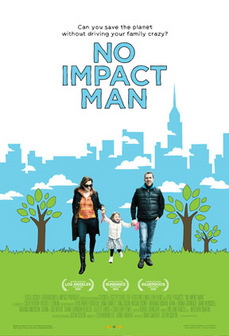 When author Colin Beavan embarked on his plan for a new book, “No Impact Man: The Adventures of a Guilty Liberal Who Attempts to Save the Planet, and the Discoveries He Makes About Himself and Our Way of Life in the Process,” he was one of many take-out-food eating, light-leaving-on, TV-watching, plastic-bag-using New Yorkers. His wife, Michelle Conlin, shopped. A lot. So the notion of spending a year making as small of an ecological imprint as possible was a definite shock to their family system.
When author Colin Beavan embarked on his plan for a new book, “No Impact Man: The Adventures of a Guilty Liberal Who Attempts to Save the Planet, and the Discoveries He Makes About Himself and Our Way of Life in the Process,” he was one of many take-out-food eating, light-leaving-on, TV-watching, plastic-bag-using New Yorkers. His wife, Michelle Conlin, shopped. A lot. So the notion of spending a year making as small of an ecological imprint as possible was a definite shock to their family system.
He started a blog, detailing how they stopped using disposables of any kind (including diapers for their daughter), took only public or human-powered transportation, and eventually went without electricity. Extreme? Yeah. That was the point.
In addition to being a bit of a gimmick to schill for his book, it appears to me to be a wholehearted, sincere effort to really become aware–and help others becaome aware–of just how much garbage we produce in this country. In the U.S. we each make about 4 pounds of trash a day–56 tons a year per person. For Colin, it wasn’t about showing off, or being right, or preaching, it was a genuine experiment to explore the question: Is it possible to live with less? And if I do, will it make me more or less happy?
That question is explored rather fascinatingly in the new documentary about their year of wriggling free from compulsary consumerism. The film opens tomorrow across the country. And even if the film-makers didn’t happen to be friends of mine (I went to junior high with the director and man behind the camera), I would tell you to go see this movie. (And I’m not alone–raves all around.) It’s not at all what it might have been–a chastizing treatise about why we should be better citizens. But it’s rather a story that takes us on an adventure–about stripping down and uber-simplifying (not always successfully) the urge to consume–be it coffee or cute clothes.
The film is also largely about the couple’s relationship–Michelle is not exactly 100 percent on board every step of the way (especially when she has to live without a fridge). But she rallies, especially when his enthusiasm starts to flag. We also watch them become semi-famous after a gigantic New York Times piece comes out and the mixed blessing that brings. One thing Michelle says in the movie that I’m still hearing echo in my brain weeks after seeing it is: “I had to let go of the person who wants things.” She means the inner shopper, the inner consumer, the inner more, more, more that is encouraged by every billboard, pop-up ad, magazine, TV commercial ever. Major. It makes me want to give that a real go too.
We also get to see that when families are not distracted by TV, numbed out by heavy food, and are walking and biking together, cooking and eating at home more–they can really increase sharing simple joys. In its own subtle, non-preachy way, we see that sometimes less is definitely more.
Check Out the Trailer
Like what you see? Click here to subscribe and get Fresh Living in your in-box every day!

